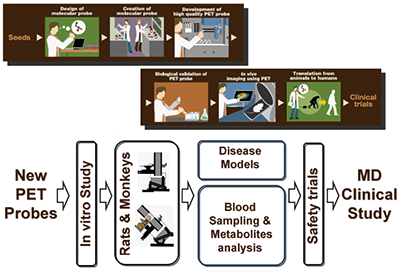- Evaluating Molecules -
Toward the practical application of PET proves
The Functional Probe Research Laboratory works in cooperation with the other teams of the Center for Molecular Imaging Science as well as of other organizations, both domestically and overseas, to develop a novel molecular probe for molecular imaging, evaluating the functional availability of a probe synthesized as a PET probe able to recognize a specific biological molecule. Our aim is to create a novel molecular probe for practical use by strategically advanced functional evaluation methods in vitro and in vivo. We are further attempting to create disease models of gene-manipulated animals in order to develop a molecular probe for clinical use. Embryonic stem cell and gene introduction techniques are used to develop regenerative medicine via longitudinal studies using the same individual non-primate subjects.

[Applications of molecular imaging technology to regenerative medicine]
Regenerative medicine includes rehabilitation, cell grafting, approches utilizing gene transfer, and engineering approaches utilizing artificial materials. To improve the yield of these regenerative medical techniques and to construct valid methodologies, it will be required optimization of longitudinal with respect to functionality, targeted migration, and fate of engrafted cells and regenerative materials. For clinical applications, we have to further develop technology for quantitative visualization during the functional recovery process in regenerative therapy. In CMIS, mainly using primates as an animal model, we are trying to apply sophisticated molecular imaging techniques for the monitoring of model animals and human recipients of regenerative medical treatment, with the goal of integrating advanced research in regenerative medicine.
[Use of PET molecular imaging for genetically modified mice and small non-human primates]
In recent years, dramatic advance in biological genetic engineering have facilitated attempts to use genetically modified animals in basic research and in drug development, and an important role for molecular imaging is developing in research using small animals. We utilize PET molecular imaging technique in a wide range of research, from basic life science research to applied research with the aim of supporting drug discovery, and we construct a research system capable of dealing with a variety of animals, from mice which are easily genetically modified to monkeys which possess higher brain function. We are also trying to apply molecular imaging techniques on animal models for various diseases with the aim of elucidating pathogenic mechanisms and determining therapeutic efficacy.








